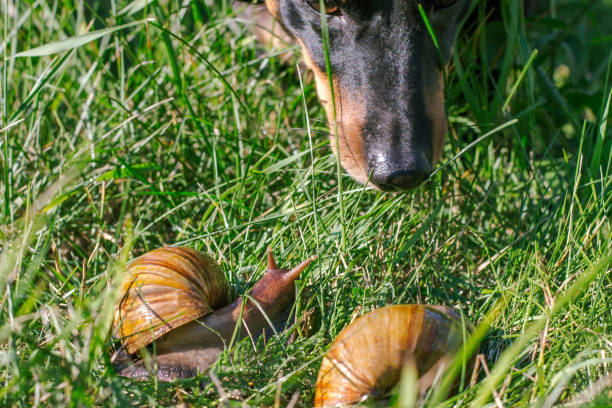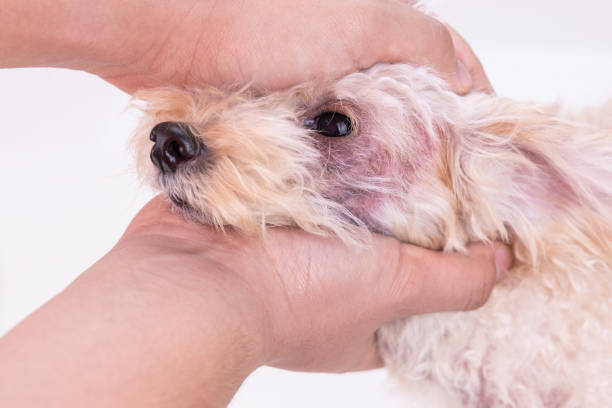If you suspect that your dog might be afflicted with lungworm, it is crucial to take it to the veterinarian urgently. You can determine the need for worm treatment by testing for lungworm eggs using a dedicated worm egg count. The supplied kit includes everything you need. It contains detailed instructions for submitting the sample by mail, and the lab will send you the test results via email within a few days. Any suggested therapies will also be communicated to you if the results indicate a need for them.
Read also: Neem – Natural Parasite Killer
You can treat your dog for lungworm one of two ways – conventionally with Advocate (UK name) which treats fleas and lungworm, or herbally with Verm-X or Four Seasons anti-parasitic tincture. If you want to treat it herbally then you MUST overlap a conventional Advocate treatment with the Verm-X. This eliminates any lungworm that has already left the gut and moved on in your dog’s body.


Simply administer a conventional lungworm treatment as normal and start on Verm-X or Four Seasons simultaneously. Both products can only eliminate any eggs or larvae that are introduced to the gut via dog swallowing. It doesn’t eliminate any parasite that has already left the gut and is sitting in the body, so by overlapping both treatments, you get rid of what’s there and allow Verm-X or Four Seasons to take over.
After that, you can use either product permanently to control lungworm. It’s a good idea to do a lungworm egg count a couple of times a year. Read on for more information on how lungworm can be fatal to your dog.
Lungworm is on the increase in the UK. It’s an insidious parasite that can be fatal if left to its own devices and, when I explain how it works, will make your skin crawl. I had a good long chat with Mark Fox, vet and lungworm expert at the Royal Veterinary College and this is the gist of what he told me.
You may also like: How to Switch to Natural Worming Products
Where Does Lungworm Come From?
Lungworm was first happened upon in the UK in 1975, hosted by a Greyhound over from Ireland. It reappeared in the ’80s in Cornwall, spread to South Wales by the nineties, and to London and the South East by the early Noughties. Since then, it’s gradually spread north with reports of lungworm in the Midlands, North of England, and Scotland.
Now widespread in the South of England and creeping northwards, a UK-wide study based on a survey of small animal practices, the first of its kind, was carried out in 2009.
It turns out we have lungworm ‘hot spots’ and ‘super hot spots’. Hot spots, regions where you’re 4-5 times more likely to see lungworm in animals, are currently South East England and Greater London; and South Wales, especially Swansea. The super-hot spots are found in the middle of those two hot spots.
Read also: The Truth About Titer Testing
It hasn’t yet been established why these hotspots have occurred. I thought it might be the ‘MMR factor’ of dog owners not wanting to use conventional wormers, so not worming at all, but apparently not.
The lungworm I’m talking about is Angiostongylus vasorum or French Heartworm. It’s sometimes called Heartworm in the UK but in warmer countries, proper Heartworm or Dirofilaria immitis is transmitted by mosquitoes. It is extremely rare in the UK but is something to be aware of if you’re travelling south with your dog.
How Does the Dog Get Lungworm?


Your dog can pick up lungworm from eating or licking slugs, snails, and frogs. Or from licking snail trails on paths or grass containing eggs. Foxes can also harbour lungworm, excreting larvae in their poo as they go, which as we all know dogs just love to roll about in. If a snail has been in your dog’s drinking water or a supply of water in the garden – a neglected plant tray or a water feature for example – lungworm can get in that way too.
Foxes don’t bury their poo but leave it, placed strategically to mark their territory. Usually outside my back door! Did you know that London has the highest population count of urban foxes in the world? Me neither, but when I lived there, I could well believe it.
There’s a theory/suggestion that lungworm is spreading across the country on nursery plants as they’re distributed to garden centres around the country. We travel more with our pets now, so taking the dog on holiday can result in more than a sunburned nose. If you’re worried about travelling with your dog you can always get in touch with your local vet to get the latest on local lungworm activity at your destination. Forewarned is forearmed and all that.
The Lungworm Travelator – How a Lungworm Works
You know when you’re heading for your departure gate at the airport, and you come to that long walkway that has a moving travelator in the middle with a walkway on either side? Now, are you going to be a lazy sod and jump on the travelator or are you going to get your last bit of exercise before you submit to hours of sedentary activity on the plane? Stick with it, there is a point to this.
Get your dog moving: 7 Ridiculously Fun Things to Do With Your Dog
If you’re a lungworm in this scenario then the travelator is your path to lungworm nirvana – the lungs.
Your dog eats or licks a slug and ingests lungworm larvae as a result. It’s now infected, and the larvae have started their journey to departure gate 12. I guess that makes your dog the North Terminal at Gatwick, but that’s pushing this analogy too far. This is serious, but I tell it as a story so it will stick in your head.
So, the larvae have moved to the gut, where it then penetrates the gut wall and enters the bloodstream lymphatic system, and eventually reach the right side of your dog’s heart where it becomes an adult worm. Here it releases eggs that hatch in the blood, making their way to the lungs rupturing the lung wall, entering the alveoli (the tiny air pockets in the lungs), and working their way up through the lungs until they reach the top.
This makes the dog cough, bringing up the lungworms. The dog swallows them and passes them through the digestive tract to exit the body in feces so the whole process can start all over again. And that, my friends, is how the lungworm travelator works.
Have a nice flight.


